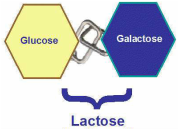
Primary lactase deficiency (hypolactasia) occurs after weaning. It is distinguished from alactasia (total lack of lactase) that is a rare congenital defect. Secondary lactase deficiency occurs due to damage to the lining of the intestine and is generally reversible. Most lactose-intolerant people can tolerate a certain level of lactose in their diets without ill effects. Higher amounts could cause abdominal bloating, cramping, flatulence, diarrhea, nausea, borborygmi, and vomiting.
Klebsiella Pneumoniae, E.coli and Enterobacter Cloacae are examples of opportunistic bacteria that live in human intestines and help to quickly digest lactose. Serratia marcescens and Citrobacter could do it too, but are slow fermenters.
